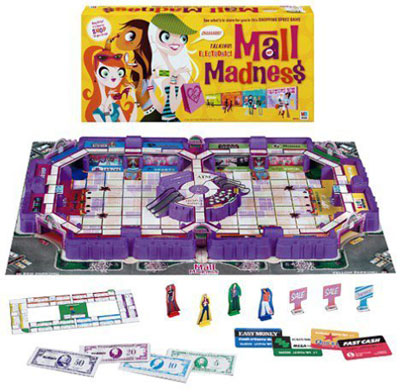Mall Madness
Classic board game of shopping and walking around
 Electronic talking shopping spree game filled with sales, clearances, and fun. The first shopper who buys six items and gets to their destination wins.
Electronic talking shopping spree game filled with sales, clearances, and fun. The first shopper who buys six items and gets to their destination wins.
The shopping mall has played a significant role in shaping American culture and consumerism, serving as both a commercial and social hub. Here is a brief history of the evolution of the shopping mall in American society:
Early Roots and Department Stores: The concept of indoor shopping spaces has roots in early American history, with the rise of department stores in the late 19th century. These stores, such as Macy's and Marshall Field's, offered a variety of goods under one roof and provided shoppers with a convenient and enclosed shopping experience, particularly in urban areas.
The Birth of the Shopping Mall: The modern shopping mall as we know it today began to take shape in the mid-20th century. One of the earliest examples is the Southdale Center in Edina, Minnesota, which opened in 1956. Developed by architect Victor Gruen, Southdale was designed as a climate-controlled space that combined retail stores with communal gathering areas. It set the stage for the mall's future development.
Suburban Expansion: As suburbs grew in popularity during the post-World War II era, so did the shopping mall. Malls were designed to cater to the needs of suburban families, offering a wide range of stores, dining options, and entertainment facilities. The mall became a symbol of modernity and convenience, and it capitalized on the car culture by providing ample parking spaces.
The Rise of Mega Malls: In the 1970s and 1980s, the shopping mall experienced a period of expansion and innovation. Developers introduced larger, multi-level shopping centers known as "mega malls." These malls featured anchor stores, such as department stores or large specialty retailers, surrounded by smaller shops and boutiques. They also incorporated elements like food courts, movie theaters, and indoor amusement areas to enhance the shopping experience.
Cultural and Social Gathering Spaces: Malls not only offered shopping but also became social and cultural hubs. They hosted events, exhibitions, and entertainment shows, transforming into community spaces for people to meet, socialize, and spend leisure time. Malls also played a role in the commercialization of holidays, with elaborate decorations and themed displays.
Challenges and Transformations: In the late 20th and early 21st centuries, the rise of e-commerce and changes in consumer behavior posed challenges to traditional brick-and-mortar retail, including shopping malls. Many malls faced declining foot traffic and tenant vacancies. In response, some malls underwent renovations to create more experiential environments, offering unique dining, entertainment, and lifestyle experiences beyond traditional shopping.
Reimagining the Mall: To adapt to changing trends, some malls embraced mixed-use developments, integrating residential spaces, offices, and entertainment venues alongside retail stores. Others focused on upscale and luxury offerings, targeting a more affluent demographic. Additionally, outlet malls gained popularity for offering discounted brand-name merchandise.
The Digital Age and Hybrid Models: The digital age brought about a transformation in shopping habits, with the growth of online shopping. To stay relevant, malls and retailers adopted omnichannel strategies, blending physical and digital experiences. Some malls integrated technology such as interactive kiosks, mobile apps, and virtual reality experiences to engage shoppers both online and offline.
The shopping mall has evolved from department stores and early enclosed shopping spaces to become an integral part of American culture. It reflects changes in consumer preferences, urban development, and technological advancements, and continues to adapt to new challenges and opportunities in the dynamic landscape of retail and commerce.
